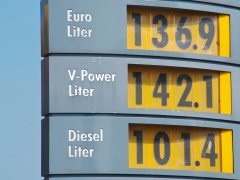Features
Driving lignin forward
Date: 2021-05-14 09:22:19.0
Author: Jon Evans

Diesel for sale.
Photo: KBF Media/Shutterstock.
Scientists have investigated various ways to make use of lignin. Mostly, this has involved trying to convert lignin into useful industrial chemicals (see Finding the value within lignin), but it has still taken scientists down some unexpected routes. For example, several research groups are looking at converting lignin into a sustainable electrolyte for use in redox flow batteries, which show great potential for storing the energy generated by renewable technologies such as solar and wind.
Perhaps the best option, however, is to convert lignin into a fuel, thus allowing biofuels to be obtained from every component of biomass, which should greatly improve the economics of the whole process. In theory, lignin can even be turned into a form of gasoline, for use as a drop-in replacement for conventional gasoline, rather than having to be mixed with it, as is the case with bioethanol.
This involves simply heating the lignin in the absence of air, but often in the presence of a catalyst, to turn it into a liquid bio-oil, in which the lignin polymer is broken down into various smaller compounds known as phenols. To convert it into gasoline, the bio-oil then needs to be upgraded, by replacing some of the oxygen in the phenols with hydrogen. This is known as hydrodeoxygenation, and scientists have developed various catalytic processes for accomplishing it.
Last year, for example, in a paper in Nature Energy, researchers from the Georgia Institute of Technology in the US reported using a combination of platinum nanoparticles on carbon, as a catalyst, and polyoxometalate acid (SiW12), as a hydrogen transfer agent, to conduct hydrodeoxygenation of lignin bio-oil (see Cheap catalysts are cool). All these catalytic processes are still at fairly early stage of development, though, and none of them are yet efficient enough for commercial development.
Now, Min Wang and his colleagues at Dalian University of Technology have investigated a slightly different approach. Rather than upgrade lignin bio-oil into a form of gasoline, they have developed a process for upgrading it into a form of diesel.
Again, catalytic hydrodeoxygenation plays a central role, but only after a separate catalytic step that forms carbon-carbon bonds between pairs of phenols, thus combining them into dimers, as diesel is made up of larger hydrocarbon molecules than gasoline. Wang and his colleagues tested the ability of various light-powered photocatalysts to perform this step, finding that a photocatalyst comprising gold nanoparticles on nanorods of cadmium sulfide worked best. It was able to pair up over 80% of a model phenol known as 4-ethyl-1-methoxybenzene in 24 hours, producing only molecular hydrogen as a by-product.
After the phenols were paired up into dimers, Wang and his colleagues performed a hydrodeoxygenation reaction on them, by exposing them to a catalyst in the presence of molecular hydrogen. They experimented with two hydrodeoxygenation catalysts – palladium on carbon (Pd/C) and cobalt molybdenum sulfide with platinum (CoMoS-P) – and found that Pd/C tended to convert the phenol dimers into cycloalkanes while CoMoS-P tended to convert them into aromatics. That was fine, however, because diesel is made up of both alkanes and aromatics.
Finally, as Wang and his colleagues report in a paper in Angewandte Chemie International Edition, they tested this upgrading process on pine sawdust, which they converted into bio-oil by heating it with a catalyst made of ruthenium on carbon. Using their process, they were able to convert this bio-oil into a diesel-like mixture of cycloalkanes and aromatics, with 28% by weight of the bio-oil converted into cycloalkanes and 38% by weight into aromatics. This is a lower conversion rate than they achieved with the model phenol, which they attributed to contaminants in the bio-oil.
So scientists have no shortage of potential uses for lignin. The task now is to make one of them efficient enough for commercial development.
The views represented here are solely those of the author and do not necessarily represent those of John Wiley and Sons, Ltd. or of the SCI.
Displaying 2 keywords used to tag this article:
- Jules Audemars-Australia Best Quali
- DG6582 Mens Moncler Down Jackets Gr
